A Government expert has admitted SAGE is ‘scratching its head’ as to why Covid infections are currently plummeting, after the group predicted around 100,000 cases per day next month.
Modelling released ahead of Freedom Day said it was realistic to expect six-figure cases in August and as many as 200,000 in a worst-case scenario.
But Britain’s daily Covid cases fell for the sixth day in a row yesterday with just 29,000 recorded, and deaths have also begun dropping, boosting hopes the third wave may have peaked weeks earlier than expected.
Exactly why cases are plummeting now at the point at which they were expected to start soaring is unknown but experts believe the drop-off may have been caused by a number of factors, including the hot weather, schools closing for summer and the ‘pingdemic’ forcing people into isolation.
Professor Sir Mark Walport, a former chief scientific adviser to the government and member of SAGE, admitted the sharp drop off in people testing positive for the virus is ‘quite surprising’.
One of the factors behind plummeting cases could be that the ‘pingdemic’ is keeping people at home rather than spreading the virus, Professor Graham Medley, chair of SAGE’s Spi-M modelling group, told MailOnline.
Another factor could be fewer children being tested now that schools are off for summer, said Dr Mike Tildesley — the scientist behind Warwick’s modelling which predicted the 100,000 figure next month.
Professor Paul Hunter, professor of medicine at the University of East Anglia, believes the country may be enjoying ‘Euro 2020 immunity’ after so many young people caught the virus over the past two months.
And Professor James Naismith, another expert at the University of Oxford, said the recent heatwave across the UK may have also played a role in encouraging people to open windows and socialise outside, which would have driven down infections.
Questions are being raised about why the SAGE models did not accurately factor in predictable factors like schools closing, warmer weather and increased immunity following a surge of cases during the Euro 2020 football tournament.

SAGE’s most recent modelling, released little more than a week before the Government eased most remaining Covid restrictions on Monday last week, suggested infections would surge to 100,000 a day by next month (purple line). Graph shows: Warwick University’s predictions, which were listed as SAGE’s central estimates, suggested cases could be as high as 60,000 at this stage of the month and still rising. Britain recorded 24,950 cases yesterday (black line). ‘Initial change’ refers to how quickly people change their behaviour — including mask-wearing, socialising and washing their hands — after restrictions were eased
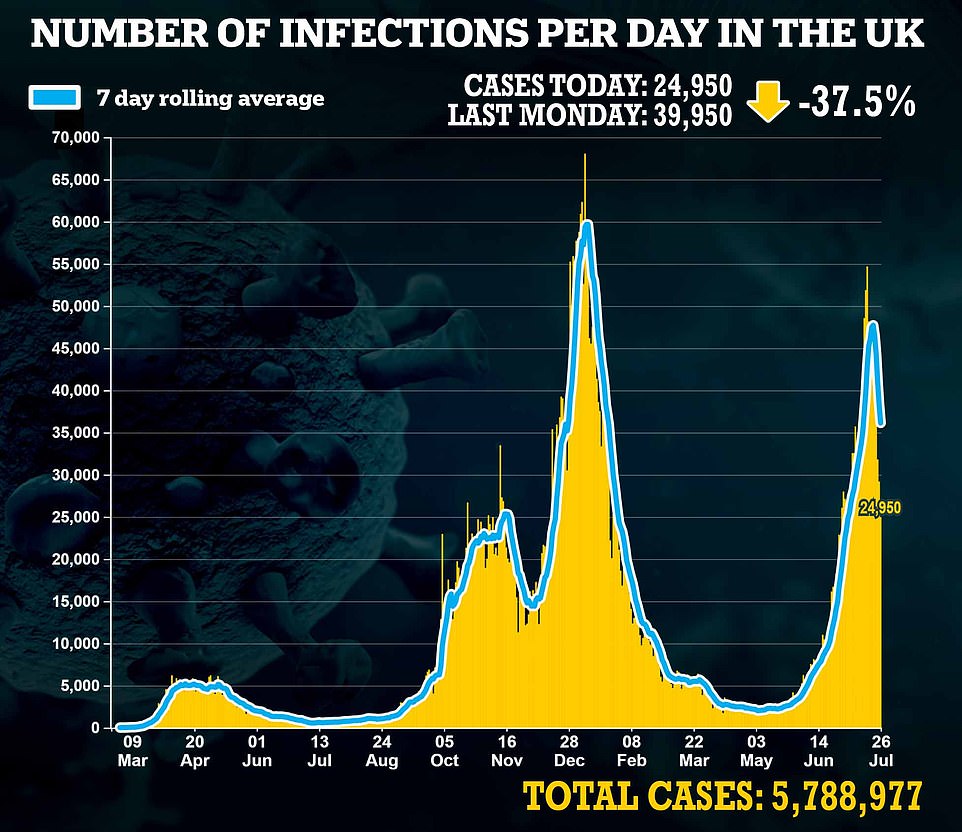
Britain’s daily Covid cases for the sixth day in a row yesterday with deaths also dropping, boosting hopes the third wave may have peaked weeks earlier than expected
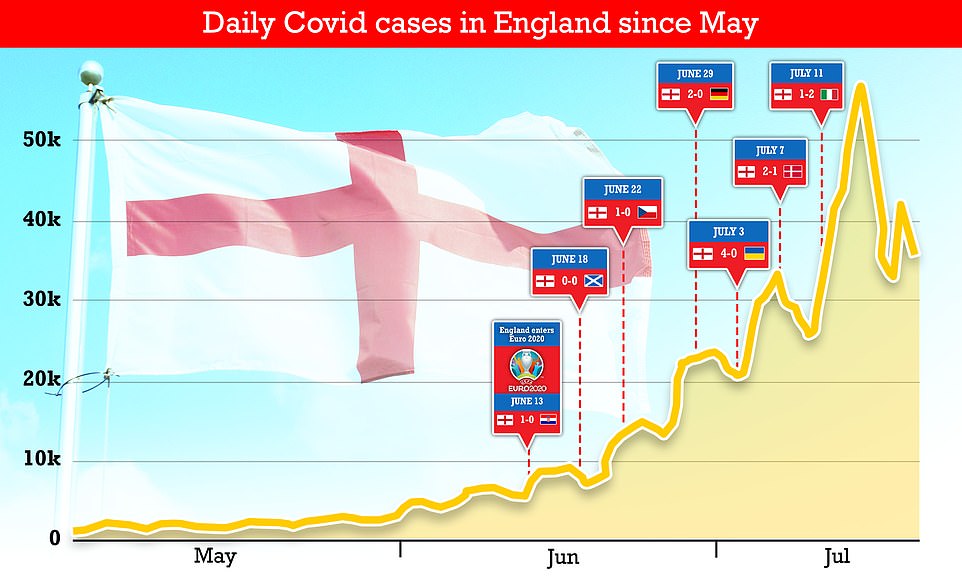
Scientists say the drop off incases could be caused by schools closing, recent warm weather and Euro 2020 boosting immunity in young people. Graph shows: The drop off in infections in England after the end of Euro 2020. There were signs in early June that cases were falling but during the tournament there was a sustained increased in infections. Experts including Professor Paul Hunter accurately predicted infections would drop off around 10 days after the final — because that is around the time it takes for the effects of increased social mixing to wear off on case numbers
SAGE’s modelling has been slammed by critics throughout the pandemic for overblowing the scale of impending waves. Professor David Livermore, a medical microbiologist at the University of East Anglia, today told MailOnline the models have been ‘off the mark many times’.
‘Professor Lockdown’ Neil Ferguson forecast as many as 250,000 deaths from the virus last Spring alone, which prompted the initial shutdown. Professor Ferguson — who’s grim modelling predicted infections could reach as high as 200,000 next month — today said the drop off in case numbers appeared to be ‘real’.
Modelling of Boris Johnson’s roadmap to freedom released in February predicted there would have been more than 200,000 additional hospital admissions before this summer. There were less than 50,000 admissions in total since the start of the roadmap.
The Prime Minister today warned against drawing ‘premature conclusions’ about the falling cases, adding the figures are yet to reflect the effects of easing restrictions on July 19.
But speaking about the drop off, Professor Walport told The Times: ‘It’s quite surprising that it has dropped quite so quickly, in such a spiky fashion.
‘It’s much better news than the alternative — but I think that everyone’s scratching their heads a little bit as to exactly what the explanation is.’
‘By October, we’ll be looking back at pandemic’: Professor Neil Ferguson reveals the ‘equation has changed’
‘Professor Lockdown’ Neil Ferguson today raised hopes that the UK will be ‘looking back’ at the pandemic by October after Covid cases fell for a sixth day running.
The epidemiologist said the effect appeared to be ‘real’ and the R number could be slightly below one — although he cautioned that the situation is still very uncertain and there might be more spikes.
He suggested the dip was down to the end of the Euros football tournament and warmer weather meaning people were mixing indoor less.
Professor Ferguson said there could be ‘uncertainty’ into the Autumn, but stressed that the calculations had ‘fundamentally’ changed due to vaccines.
‘I’m positive that by late September, October time, we will be looking back at most of the pandemic,’ he said.
‘We’ll still have Covid with us, we’ll still have people dying from Covid, but we will put the bulk of the pandemic behind us.’
Experts have suggested that high numbers of young people catching the disease during the Euros could have helped to squash the latest peak, as they now have some immunity and otherwise may not have been vaccinated.
Advertisement
There were 14 deaths yesterday, down nearly a quarter on the 19 recorded last Monday, and the lowest number since July 12.
The last time fatalities dipped was on July 18, when they fell only slightly by 3.8 per cent.
Yesterday’s cases drag the seven-day average down to 36,125 from a third wave peak of 47,696 last Wednesday, a drop of 24 per cent in the last six days.
Professor Medley told MailOnline: ‘The current fall in cases is a bit puzzling, so there probably isn’t a simple explanation.
‘If infections were falling because of immunity, then it would not happen everywhere at the same time. The only thing that happened everywhere in England at the same time was the football.
‘We have also been vaccinating younger people in the past few weeks, and vaccination takes some time to develop immunity. There is a changing in testing behaviour – although the number of positive tests has fallen, the proportion of tests that are positive has remained quite high.
‘The “pingdemic” meant a lot of people isolating, and you can’t get infected if you are isolating so a side effect of the “pingdemic” might be to reduce infection rates.
‘We will see in the coming days if hospital admissions start to fall.
‘If they do, then it does suggest that we have got over this wave, which turned out to be quite small. This doesn’t mean that we will not see more waves, but it is very encouraging.’
And other Government advisors have credited the fall off with schools closing — despite modellers knowing this would be occurring before releasing their predictions.
Dr Jewell told The Times: ‘We will know more as the week unfolds, but certainly our current model-based estimates have gone from R [being roughly] one three days ago to R being less than one today.
‘The fall in cases is slightly perplexing. I suspect that it has something to do with schools breaking up and contact patterns changing.’
School children were required to have a lateral flow test for the virus twice a week. Many schools around the country shut last week for the summer break but the majority will only go off this week.
Government figures show about 1.01million swabs were carried out in Britain on July 22, the most recent date, down five per cent on 1.18million in the previous week. This drop is unlikely to be the sole reason behind the sharp decline in cases.
His comments echoed Dr Tildesley who yesterday suggested the decline in cases may be the result of fewer children being tested for the virus now that schools are off for summer.
Figures show there were 6.8m carried out in the week up to July 22, down by 350,000 on the previous week (4.9 per cent). The drop off is substantially less than those seen in infections (37.5 per cent in a week yesterday).
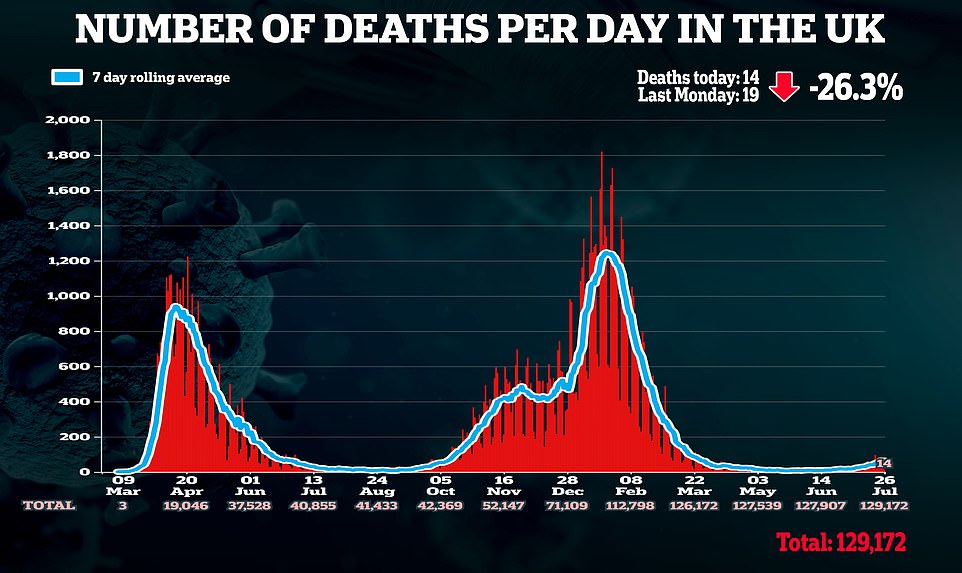

Dr Jewell added that cases may be artificially low at the moment because people ‘may be less inclined to get tested if they have summer holidays booked’.
However, James Davidson at the private Corona Test Centre, which sells rapid antigen tests for travel as well as PCR and antibody tests for general testing, told MailOnline demand for all testing was actually increasing because of peoples’ desire to go on holiday.
He said: ‘The demand for travel is only rising as more people look to go abroad. Off the back of this, we’ve found that the public are using our tests more than ever to ensure this is possible for them.
‘While Covid cases have been going down, when it comes to tests we’ve seen the opposite at Corona Test Centre, with the number of people coming in to get tested higher than ever before.
‘The number of people coming into our clinic is up by nearly 50 per cent compared to our June numbers, with a huge surge of interest for destinations such as Tenerife and Lanzarote, which have increased nearly 6000 per cent month on month.’
Other experts have suggested the fall in England could be a result of immunity building in young people after meeting up to watch Euro 2020 games in the country’s run up to the final on July 11.
Infections continued to rise for four days — the average incubation time for the virus — after England’s loss to Italy on penalties before beginning to drop off.
Professor Paul Hunter, professor of medicine at the University of East Anglia, suggested the tournament may have inadvertently helped young unvaccinated people gain immunity earlier than expected through natural infection.
He said: ‘A lot of people might be disgusted by me saying this, but ultimately the Euros might turn out to be one of the things that make the rest of the summer less stressful, as we’ve effectively immunised a lot more younger people who wouldn’t otherwise have come for or been available for a vaccine. But I would stress that I would never suggest that as a control strategy in advance.’
Professor Ferguson likewise suggested the dip was down to the end of the Euros football tournament and warmer weather meaning people were mixing indoor less.
He said there could be ‘uncertainty’ into the Autumn, but stressed that the calculations had ‘fundamentally’ changed due to vaccines.
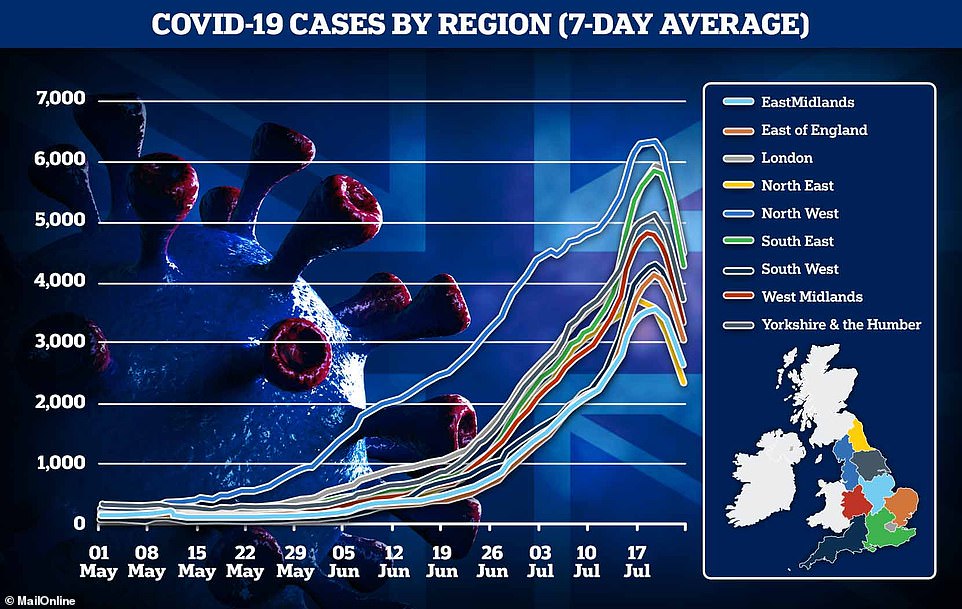
As well as national case rates coming down, the latest regional data from the Government’s coronavirus dashboard appears to show a decline or levelling off in every corner of England. Scientists still don’t know what has caused the sharp fall, but suspect it may be several contributing factors

SAGE modeller Dr Mike Tildesley said the fall in cases may be partly the result of a dip in testing. Figures show there were 6.8m carried out in the week up to July 22, down by 350,000 on the previous week (4.9 per cent)
TESTING DIPS, WARM WEATHER, RISING ANTIBODIES AND EURO 2020: THE LEADING THEORIES ON UK’S FALLING INFECTIONS
SAGE experts had predicted Britain could face more than 100,000 cases a day by August.
But the country’s Covid cases have now tumbled for six days in a row to just under 25,000 on Monday, suggesting the worst of the third wave may already be over.
But scientists are stumped as to what has sparked the downturn. Below are the leading theories.
School holidays ‘have led to fewer tests’
Some experts have suggested the school holidays may have played a role in the fall in infections.
School children were required to have a lateral flow test for the virus twice a week.
Many schools around the country shut last week for the summer break but the majority will only go off this week.
Government figures show about 1.01million swabs were carried out in Britain on July 22, the most recent date, down five per cent on 1.18million in the previous week.
This drop is unlikely to be the sole reason behind the sharp decline in cases.
Euro 2020-fuelled rise ‘has ended’
Professor Paul Hunter, an epidemiologist from the University of East Anglia, believes that cases were falling before Euro 2020 and only started to rise again due to increased mixing during the tournament.
In Scotland, cases started to fall after an immense spike 10 days after their final game in the competition.
Cases in England have followed an almost exact trend following the national team’s loss in the final at Wembley on July 11.
However, Professor Hunter, like many other scientists, are warning that it is too early for the effects of Freedom Day on July 19 to start impacting the numbers.
They have warned it is possible they could begin growing ‘exponentially’ again in the coming weeks.
There is a lag in time between a person catching the virus, showing symptoms and receiving their test results before noticeable trends appear in the figures.
Dr Simon Clarke, a microbiologist at Reading University, said cases were now dipping to where they would have been without the Euro-fuelled surge.
More than nine in ten adults are now immune to Covid
Surging immunity against the virus will also be behind the drop in cases.
Office for National Statistics estimates say 92 per cent of adults now have antibodies against the virus.
The proteins are produced after vaccination or real Covid infection. They signal at least some form of immunity.
With more than 70 per cent of the adult population fully vaccinated, the jab rollout has played a huge role in the boosting antibody levels.
Summer weather leads to more time outdoors
The heatwave that struck the UK could also be behind the fall in cases, experts say.
Summery weather is allowing people to spend more time outside, where the virus finds it harder to infect others.
Numerous studies have also shown that warm weather kills off the virus and stops it from being passed from person to person.
But with rain now forecast for the next week, this situation could change.
Advertisement
The epidemiologist this morning said: ‘I’m positive that by late September, October time, we will be looking back at most of the pandemic.
‘We’ll still have Covid with us, we’ll still have people dying from Covid but we will put the bulk of the pandemic behind us.’
Summery weather is allowing people to spend more time outside, where the virus finds it harder to infect others.
Numerous studies have also shown that warm weather kills off the virus and stops it from being passed from person to person. But with rain now forecast for the next week, this situation could change.
Professor Livermore criticised SAGE’s models for failing to acknowledge cases peaked before each of the three British lockdowns.
He told MailOnline: ‘The modellers’ predictions have been off the mark many times
‘The evidence is that UK rates were peaking before each of the three UK lockdowns.
‘The Ferguson model predicted almost 100,000 deaths in the first three months in Sweden if they did not lock down, yet the tally, still with no lockdown, was around 5,000.’
He continued: ‘They also need to reflect a little history — the 1918 flu pandemic peaked in Europe and New York around the end of October and in the first few days of November.
‘November 11 [Armistice Day] and the days afterwards then prompted wild revels — events that make Freedom Day look like a vicarage tea party.
‘Any modeller would predict that this would reignite the pandemic but it didn’t. Deaths fell away through November.
‘This illustrates a repeated problem for modellers. They extrapolate lines based on R numbers, contacts, projected immunity et cetera, but I’ve yet to see them devise a model that accurately describes a historic pandemic based on being fed day-by-day data.’
Daily infections now appear to be falling or levelling off in every region of England. The North East, a hotspot for the Indian ‘Delta’ variant, was the first to see its outbreak peak on July 14, according to the data.
Speaking during a visit to Surrey Police HQ in Guildford, Mr Johnson said: ‘I’ve noticed, obviously, that we are six days in to some better figures.
‘But it is very, very important that we don’t allow ourselves to run away with premature conclusions about this.
‘Step four of the opening-up only took place a few days ago, people have got to remain very cautious and that remains the approach of the Government.’
Mr Johnson acknowledged people’s frustrations about the self-isolation system but insisted they had to ‘stick with the programme’..
The Prime Minister, on his first visit since being released from self-isolation, said: ‘I know that people have been frustrated about the pinging and the self-isolation.
‘I totally understand that, particularly now as we’re starting to see some better figures.
‘But I think everybody understands that this is still a very dangerous disease.
‘We do need to use the tools that we have. Self-isolation is the one that we’ve got. I urge people to do it.’
The new test-to-release system would come in on August 16 but ‘until then, please could everybody stick with the programme’, he said.
Asked whether students would need to be fully vaccinated to attend lectures and football fans double-jabbed to go to matches, Mr Johnson said the ‘young people of this country are doing an incredible job of coming forward to get vaccinations’.
He added: ‘The figures are outstanding. It’s almost 70 per cent now of 18-20 year-olds who have come forward to get jabs, it’s just wonderful.
‘It is a great thing to do. I would just say that my message to everybody is: get your first jab if you haven’t yet got one, but get your second jab too.
‘It will help protect you, protect your family and help us all to move forward.’
The effects of July 19’s Freedom Day on transmission won’t be felt until later this week due to the lag between someone catching and testing positive for the virus.
Professor Naismith, director of the Rosalind Franklin Institute at University of Oxford, yesterday said before today’s cases were updated: ‘Any drop in case numbers is great news and to be warmly welcomed.
‘I hope these testing numbers which show such a rapid drop in infections are an accurate reflection of reality. The roll out of vaccines in the UK has clearly made a huge difference to hospitalisations and deaths.
‘The warmer summer days have also helped. Recent weeks have seen a real drop in the number of first vaccinations. I would urge the government, medics and my fellow scientists to continue to explain to the vaccine hesitant the benefits of these safe and effective medicines.’
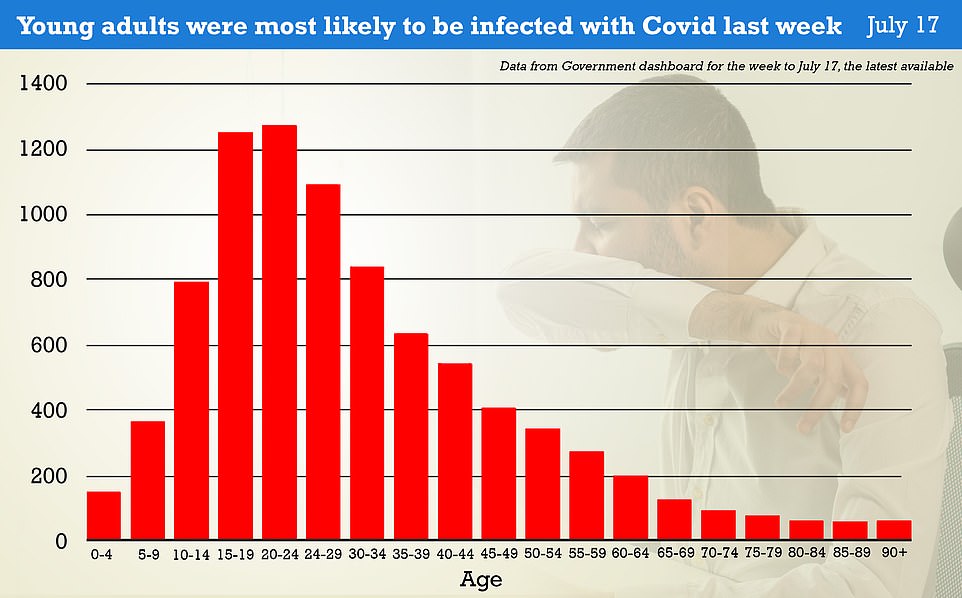
Government dashboard data shows Covid case rates were highest among young adults and school-age children. But they were much lower among the over-80s. It is not yet clear which age group is driving the fall in cases
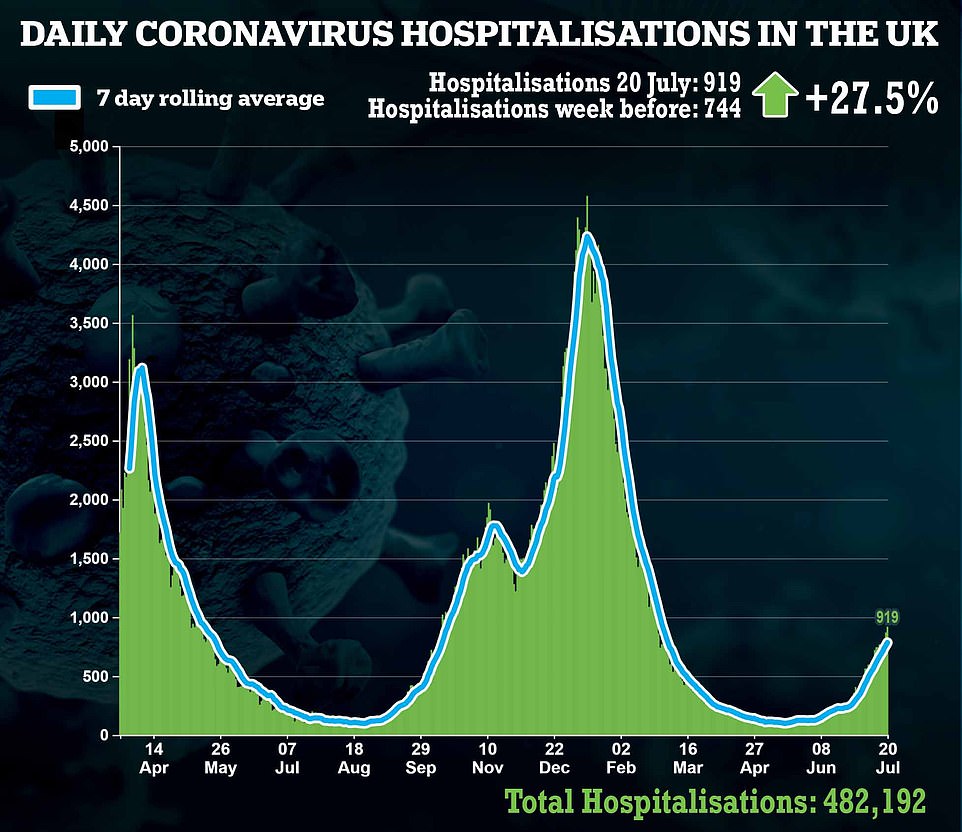
He added: ‘It is important to understand that the daily test numbers will only begin to see the effect of the end of lockdown towards the end of this week.
‘Many scientists, myself included, expect the end of lockdown to see a rise in cases. However, we have been wrong before and we will be wrong in the future. Only charlatans claims omniscience. This is a new disease and we are learning more every day.’
Latest data shows infections fell by 18 per cent across England in the week to July 20, dropping from 42,000 to less than 35,000 a day.
Broken down by age group the figures showed adults in their early twenties in England are most likely to be infected with Covid after one in 78 tested positive for the virus over the week to July 17, the latest available (Or 1,276 cases per 100,000 people in the group).
Schoolchildren aged 15 to 19 were the second most likely to have the virus after one in 79 tested positive (1,253 per 100,000), followed by 25 to 29 year olds at one in 91 (1,093 per 100,000).
On the other hand, over-80s were least likely to be infected after one in 1,666 tested positive for the virus last week (60 per 100,000).
They were followed by adults in their early 80s at one in 1,587 (63 per 100,000) and the over-90s at one in 1,562 (64 per 100,000).
Older adults are most at risk of serious disease, hospitalisation and death if they catch the virus, which has led to many preferring to stay at home and only meeting in small groups to avoid becoming infected.
But younger people generally do not see the virus as a threat. Because of this they are also less likely to get vaccinated against the virus — which cuts the risk of infection — than those in older age groups.
It is not yet clear which age groups are seeing infections drop because cases across the country only peaked a few days ago.
Why are Covid infections plunging… and will they go up again? We answer the vital questions amid signs pandemic could be easing
By ELEANOR HAYWARD, HEALTH CORRESPONDENT FOR THE DAILY MAIL
Ever since Boris Johnson unveiled plans to end lockdown rules, Britons have faced wave after wave of sombre warnings.
New Health Secretary Sajid Javid said cases could reach 100,000 a day. Neil Ferguson of Imperial College London – dubbed ‘Professor Lockdown’ – said it could be 200,000.
Government scientists on the Sage committee said they could not rule out a summer wave of hospitalisations bigger than the winter peak, putting the NHS at risk of collapse.
And Professor Chris Whitty, the chief medical officer, suggested the situation in hospitals could rapidly get ‘quite scary’.
The reality, at least so far, has been rather different. For six consecutive days, cases have dropped – the first time this has happened in months.
Yesterday’s total of 24,950 cases is down 38 per cent from last Monday’s total of 39,950. It is half the summer peak of 54,674 recorded on July 17.
It now seems clear this is a sustained fall. But what is driving it? And is it too soon to say the tide has turned?
VACCINATION

Without vaccines, the UK would probably still be in lockdown. But the jab rollout means the virus now faces a ‘wall of immunity’
Without vaccines, the UK would probably still be in lockdown. But the jab rollout means the virus now faces a ‘wall of immunity’.
Nine in ten adults have had one dose, while seven in ten are double-jabbed. Analysis by health officials suggests the rollout has prevented 7.2million infections in England.
In this respect, the controversial decision to postpone ‘Freedom Day’ planned for June 21 by a month appears to have paid off, as it bought time for millions of Britons to get their second jab.
One dose of the AstraZeneca or Pfizer vaccine is between 30 and 36 per cent effective at preventing a symptomatic Covid infection. But after two doses, that rises to 67 per cent for AstraZeneca and 88 per cent for Pfizer.
The jabs are even more effective against hospitalisation and death. Ultimately, as Professor Adam Finn, from the University of Bristol, says: ‘Vaccination is the only weapon we have that can really snuff the virus out.’
HERD IMMUNITY
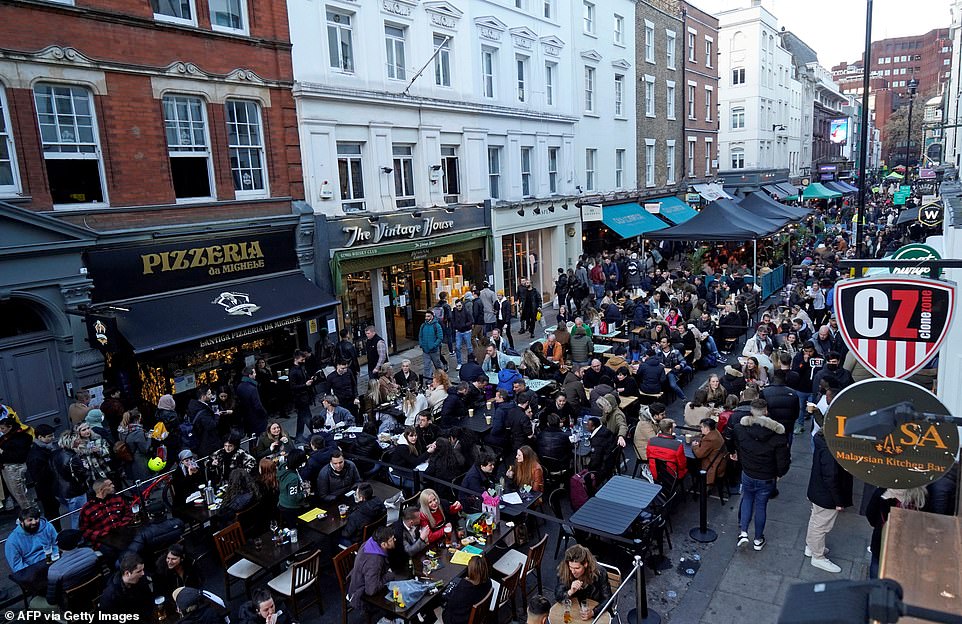
Herd immunity can be achieved either through natural infections or vaccination. The latest data shows nine in ten adults in the UK have antibodies which fight off Covid-19 infection
Once they emerge, diseases rarely leave. Smallpox is the only disease in history to have been successfully eradicated. Most simply fade into the background through the process of herd immunity – when enough of the population are immune, the virus starts to run out of new people to infect.
Herd immunity can be achieved either through natural infections or vaccination. The latest data shows nine in ten adults in the UK have antibodies which fight off Covid-19 infection. But children – who make up one in five of the population – are not being vaccinated, hampering progress towards population immunity.
However, because cases are so high in the young, many have acquired antibodies through infection.
The herd immunity threshold depends on how infectious a virus is. With the Wuhan strain of Covid-19, one infected person passed it to three others, meaning the herd immunity threshold was about 67 per cent.
Because the Indian variant is twice as infectious, the herd immunity threshold is higher – 85 per cent. But Britain may be approaching this point.
SCHOOL HOLIDAYS/TESTING

Schools broke up for summer last week, halting the spread of the virus in classrooms. This also led to a drop in testing, as secondary school children are no longer required to do lateral flow tests twice a week
Schools broke up for summer last week, halting the spread of the virus in classrooms. This also led to a drop in testing, as secondary school children are no longer required to do lateral flow tests twice a week.
However, this drop in daily testing cannot entirely explain the vast reduction in cases.
Those who have caught Covid for the second time are not being included in the daily totals, but these reinfections currently make up only around one in 200 positive tests, meaning they would add only a few hundred cases to the daily count.
END OF THE EUROS

Football didn’t come home in the end, but the Euros are thought to have triggered a significant surge in cases as millions gathered indoors to cheer on Gareth Southgate’s side
Football didn’t come home in the end, but the Euros are thought to have triggered a significant surge in cases as millions gathered indoors to cheer on Gareth Southgate’s side.
In the two weeks to July 11 – when England lost to Italy in the final – cases almost doubled. For the first time since the pandemic began, a significant gender gap emerged, with men in their 20s by far the most likely group to test positive.
Scientists say this may have been a blessing in disguise as it ‘effectively immunised a lot more younger people who wouldn’t otherwise have come for or been available for a vaccine’.
WEATHER

Summer provides a ‘natural firebreak’ against the virus as people gather outdoors where it rarely spreads
Summer provides a ‘natural firebreak’ against the virus as people gather outdoors where it rarely spreads.
Before the storms of the weekend, Britain had enjoyed a sustained period of hotter, sunnier weather which may have contributed to the decline in spread.
However, officials fear that Covid could return with a vengeance when it gets colder, taking advantage of cosy indoor gatherings with poor ventilation. Scientists warn that the UK is facing a ‘triple threat’ of flu, Covid, and resurgent respiratory viruses this winter.
PINGDEMIC

It may have ground the economy to a standstill, but the ‘pingdemic’ has also effectively placed millions in lockdown once again, cutting the spread of the virus
It may have ground the economy to a standstill, but the ‘pingdemic’ has also effectively placed millions in lockdown once again, cutting the spread of the virus.
Dr Stephen Griffin, from the University of Leeds, said the huge numbers self-isolating ‘could have a direct impact upon transmission’.
The public also appear to have heeded warnings from scientists and are taking things much more cautiously than before the pandemic.
Many are still working from home and measures such as wearing masks on public transport have helped to control the spread of the virus.
BUT IT’S NOT OVER YET…
FREEDOM DAY
Scientists say we won’t know the impact of ‘Freedom Day’ on infection levels until the end of this week. Scrapping compulsory face masks and allowing mass gatherings are all likely to have increased spread among young people.
It means the bleak predictions of 100,000 cases a day may still be realised.
HOSPITAL PRESSURES
Despite warnings from Sage, it seems unlikely Covid admissions will get close to January levels – when there were nearly 40,000 in hospital.
But health chiefs have warned that even a small rise in hospitalisations could put the NHS under severe strain, potentially requiring another lockdown.
Last night NHS Providers, which represents hospital trusts, said the health service was already as stretched as it was in January.
Source link : https://www.dailymail.co.uk/news/article-9829681/Covid-19-UK-SAGE-expert-says-group-left-scratching-head-falling-infections.html











